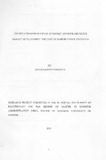| dc.description.abstract | The stock market is a common feature of a modem economy and performs functions which are thought to promote the growth and development of the economy. It plays an important role in the growth of commerce and industry which ultimately affects the economic growth of the host country to a larger extent. However, the nature and direction of relationship between stock market development and a country’s economic growth rate is doubted and debated in economic literature. Therefore, the purpose of this study was to explore the nature of the relationship between stock market development and Kenya’s economic growth.
The study employed a regression model complemented by a granger causality test. The relationship was investigated by using two measures of stock market development, namely; size of the market and liquidity. These two measures were regressed against economic growth rate. The study defines Stock market size as the share of market capitalization over GDP (referred to as market capitalization ratio); and , market liquidity as volume of share traded over GDP (referred to as value of shares traded ratio) and volume of shares traded over market capitalization (referred to as turnover ratio). The study used data from the year 2000 quarter two (2) to 2010 quarter one (1), that is, a ten years period.
The result indicates that there is a positive relationship between economic growth and stock market development in Kenya. The granger causality test indicated that the nature of the relationship is from stock market development to economic growth. The study findings also indicated that stock market liquidity, as opposed to stock market size, promotes economic growth; a unit increase in the turnover ratio would lead to increase in GDP % by factors of 325.56. On the other hand, a unit increase in market capitalization ratio would lead to decrease in GDP % by factors of 3.102. However, with 14.9% R-squared, the current results indicate that economic growth in Kenya is inadequately explained by the model. By implication 14.9% variation in the growth of economic activities is explained by the independent variables employed in the model. The recommendation therein is for policy makers come-up with ways to promote stock market liquidity and the necessary enabling stock market development environment. | en_US |


